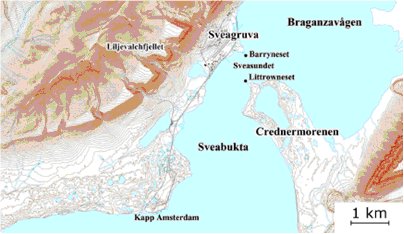
|
GISSAC
Duration: 2004-2009 Location: Field site at Svea, Svalbard. Labroatory study at LRPC, Nancy Construction in the arctic region involves special challenges related to temperature regime and climatic conditions, in addition to the great forces that can be generated by ice movements. The access to suitable fill material is low, making it complicated and expensive to build roads and harbours etc. Often, as at Svalbard, the local geology does not provide high quality gravel or crushed rocks, and at the sites where it is available environmental considerations prevent exploitation. The GISSAC-project was initiated as an answer as to how one can build environmental friendly soil structures in the Arctic by using locally available geological materials together with geosynthetics. The project partners arranged a workshop in Longyearbyen in autumn 2004 to look into current experiences and possible application areas for research and development. The outcome of a literature study performed by SINTEF and the outcome of the seminar is presented in a SINTEF report. Based on the seminar a pilot study was initiated to study the behaviour of a geotextile bag filled with local material in Longyearbyen (Svalbard). The pilot study was performed by Store Norske Spitsbergen Grubekompani (SNSG) with follow-up from SINTEF/NTNU/UNIS/TENCATE/LRPC. The outcome of this study is presented in an UNIS report. The local coal-mining company, Store Norske Spitsbergen Grubekompani (Store Norske), offered to co-sponsor a PhD position at UNIS and was looking for a candidate that would look into some of the technical challenges connected with the construction of a road from Barryneset to Crednermorenen. Such a road would have to be built in order to access the coal prospect of Ispallen on the south side of the Bay of Braganza (Braganzavågen). At the same time TenCate France wanted to develop products adapted to cold climates. The demand for such products is expected to grow rapidly. The study of the behaviour of geosynthetic bags for erosion control was performed by building a test breakwater protected with 150 bags at Svea, Longyearbyen. The behaviour of the bags, the ice forces, wave action and climate impact have been monitored and evaluated thoroughly through the past three years and the results can be studied in a thesis from UNIS and in a SINTEF-report.
The goals for the project have been:
The project was funded by grants from Foundation Franco-Norwegienne, Store Norske Spitsbergen Grubekompani and Statoil. GISSAC was concluded with a successful seminar in Longyearbyen September 21st 2009. |
Partners: SINTEF Byggforsk | |
